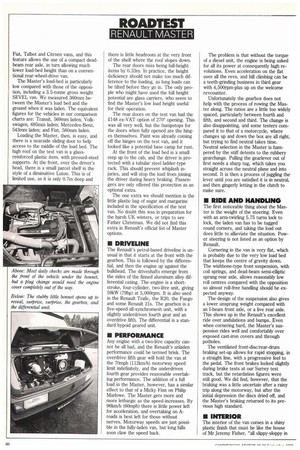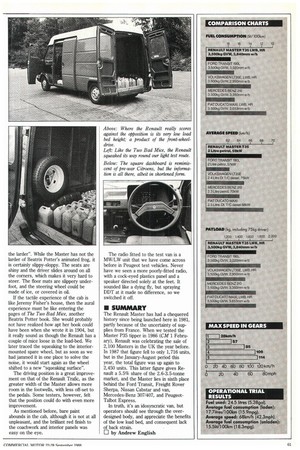RENAULT'S
Page 35

Page 36

Page 37

If you've noticed an error in this article please click here to report it so we can fix it.
BIG RED SHED
Bare and utilitarian, or cleverly styled to fill a perceived market niche, the Renault Master has plenty of Gallic character — but faces some well-entrenched opposition
MI Nonconformist, idiosyncratic, or just plain weird, the Renault Master certainly looks different from any other 3.5-tonne panel van on the market. Don't be fooled, however, by the shape of the bodyshell that looks as though it is entirely derived from the best utilitarian principles of French engineering.
Every panel was designed with a desired effect in mind. You are supposed to think that the dummy sliding side-door on the offside is a clever way of saving money for operators, and that the application of an angle grinder, and a morning's work will result in, voila, another sliding door on the offside of the Master.
The same feeling is expected when one looks at the bare paint on the door tops, the bare floor on the load-bed, or even the spartan square instrument panel, so reminiscent of pre-war Citroens. The impression ,Oven is that Renault has been frugal, and clever with the design of the Master, and has had the best interests of the operator in mind. There are no highfaluting extras, or costly embellishments to waste a penny of the £10,565 ex-VAT purchase price.
Horse feather& Although the Master gives the impression of honest frugality and value-for-money, that impression is as manufactured as a Rolls Royce's impression of opulence, or a Ferrari's impression of speed. The Renault, which looks like the Battkstar Galactica from one side, and a priest's skull cap from the other, is really no more utilitarian that any of its opposition, and is as surely, and as craftily "placed" in the commercial vehicle market as its arch rival, the Ford Transit.
• BODYWORK
The Renault commercial-vehicle range mirrors much of the current thinking of the opposition in its make up. Like the Freight Rover Sherpa or the Ford Transit, the Renault range falls between the heavy Master and lighter Trafic ranges at around 2,700kg gross weight, so the ligher vehicles can get better payload by virtue of lighter construction, and lowerpowered engines. The range also offers front-wheel-drive, like the SEVEL-built Fiat, Talbot and Citroen vans, and this feature allows the use of a compact deadbeam rear axle, in turn allowing much lower load-bed height than on a conventional rear-wheel-drive van.
The Master's load-bed is particularly low compared with those of the opposition, including a 3.5-tonne gross weight SEVEL van. We measured 360nun between the Master's load bed and the ground when it was laden. The equivalent figures for the vehicles in our comparison charts are: Transit, 569mm laden; Volkswagen, 695min laden; Mercedes-Benz, 543rnm laden; and Fiat, 560mm laden.
Loading the Master, then, is easy, and there is a nearside sliding door to help access to the middle of the load bed. The high roof on the test van is a glassreinforced plastic item, with pressed-steel supports. At the front, over the driver's head, there is a small parcel shelf in the style of a dirninuitive Luton. This is of limited use, as it is only 0.7m deep and there is little headroom at the very front of the shelf where the roof slopes down.
The rear doors miss being full-height items by 0.33m. In practice, the height deficiency should not make too much difference to the loading, as long loads can be tilted before they go in. The only people who might have used the full height potential are glass carriers, who seem to find the Master's low load height useful for their operation.
The rear doors on the test van had the £148 ex-VAT option of 270° opening. This was all very well, but the bumpstops for the doors when fully opened are the hinges themselves. Paint was already coming off the hinges on the test van, and it looked like a potential base camp for rust.
At the front of the load bed is a small step up to the cab, and the driver is protected with a tubular steel ladder-type rack. This should prevent whiplash injuries, and will stop the load from joining the driver during heavy braking. Passengers are only offered this protection as an optional extra.
The one extra we should mention is the little plastic bag of sugar and margarine included in the specification of the test van. No doubt this was in preparation for the harsh UK winters, or trips to see Father Christmas. We did not find this extra in Renault's official List of Master options.
• DRIVELINE
The Renault's petrol-based driveline is unusual in that it starts at the front with the gearbox, This is followed by the differential, and then the engine up against the bulkhead. The driveshafts emerge from the sides of the finned aluminum alloy differential casing. The engine is a shortstroke, four-cylinder, two-litre unit, giving 59kW (79hp) at 5,000rpm. It is also used in the Renault Trafic, the R20, the Fuego and some Renault 21s. The gearbox is a five-speed all-synchromesh unit, with a slightly underdriven fourth gear and an overdrive fifth. The differential is a standard hypoid geared unit.
• PERFORMANCE
Any engine with a two-litre capacity cannot be all bad, and the Renault's unladen performance could be termed brisk. The overdrive fifth gear will hold the van at the 70mph (112km/h) motorway speed limit indefinitely, and the underclriven fourth gear provides reasonable overtaking performance. The addition of a full load in the Master, however, has a similar effect to that of a Micky Finn on Philip Marlowe. The Master gets more and more lethargic as the speed-increases. By 961un/h (60mph) there is little power left for acceleration, and overtaking on Aroads is best left for those without nerves. Motorway speeds are just possible in the fully-laden van, but long hills soon claw the speed back. The problem is that without the torque of a diesel unit, the engine is being asked for all its power at consequently high revolutions. Even acceleration on the flat uses all the revs, and hill climbing can be a teeth-grinding business in third gear with 4,500rpm-plus up on the welcome revcounter.
Unfortunately the gearbox does not help with the process of rowing the Master along. The ratios are a little too widely spaced, particularly between fourth and fifth, and second and third. The change is also disappointing, and some testers compared it to that of a motorcycle, where changes up and down the box are all right, but trying to find neutral takes time. Neutral selection in the Master is hampered by the stiff detents to the rubbery gearchange. Pulling the gearlever out of first needs a sharp tug, which takes you straight across the neutral plane and into second. It is then a process of juggling the lever until you are satisfied it is in neutral, and then gingerly letting in the clutch to make sure.
• RIDE AND HANDLING
The first noticeable thing about the Master is the weight of the steering. Even with an arm-twirling 5.75 turns lock to lock, the laden van has to be tugged round corners, and taking the load out does little to allieviate the situation. Power steering is not listed as an option by Renault.
Cornering in the van is very flat, which is probably due to the very low load bed that keeps the centre of gravity down. The wishbone-type front suspension, with coil springs, and dead-beam semi-elliptic sprung rear axle, allows reasonably low roll centres compared with the opposition so almost roll-free handling should be expected anyway.
The design of the suspension also gives a lower unsprung weight compared with an I-beam front axle, or a live rear axle. This shows up in the Renault's excellent ride over undulations and bumps. Even when cornering hard, the Master's suspension rides well and comfortably over exposed cast-iron covers and through potholes.
The ventilated front-disc/rear-drum braking set-up allows for rapid stopping, in a straight line, with a progressive feel to the pedal. The front brakes locked slightly during brake tests at our Surrey test track, but the retardation figures were still good. We did find, however, that the braking was a little uncertain after a rainy trip along the motorway, but after the initial depression the discs dried off, and the Master's braking returned to its previous high standard.
• INTERIOR
The interior of the van comes in a shiny plastic finish that must be like the house of Mr Jeremy Fisher, "all slippy-sloppy in the larder". While the Master has not the larder of Beatrix Potter's animated frog, it is certainly slippy-sloppy. The seats are shiny and the driver slides around on all the corners, which makes it very hard to steer. The floor mats are slippery underfoot, and the steering wheel could be made of ice, or covered in oil.
If the tactile experience of the cab is like Jeremy Fisher's house, then the aural experience must be like entering the pages of The Two Bad Mice, another Beattix Potter book. She would probably not have realized how apt her book could have been when she wrote it in 1904, but it really sound as though the Renault has a couple of mice loose in the load-bed. We later traced the squeaking to the interiormounted spare wheel, but as soon as we had jammed it in one place to solve the noise, it would start again as the wheel shifted to a new "squeaking surface".
The driving position is a great improvement on that of the Renault Trafic, as the greater width of the Master allows more room in the footwells, with less off-set to the pedals. Some testers, however, felt that the position could do with even more improvement.
As mentioned before, bare paint abounds in the cab, although it is not at all unpleasant, and the brilliant red finish to the coachwork and interior panels was easy on the eye. The radio fitted to the test van is a MW/LW unit that we have come across before in Peugeot test vehicles. Never have we seen a more poorly-fitted radio, with a cock-eyed plastics panel and a speaker directed solely at the feet. It sounded like a dying fly, but spraying DDT at it made no difference, so we switched it off.
• SUMMARY
The Renault Master has had a chequered history since being launched here in 1981, partly because of the uncertainty of supplies from France. When we tested the Master P35 tipper in 1986 (CM 1 February), Renault was celebrating the sale of 2,100 Masters in the UK the year before. In 1987 that figure fell to only 1,716 units, but in the January-August period this year, the total figure was up again to 2,450 units. This latter figure gives Renault a 5.5% share of the 2.6-3.5-tonne market, and the Master lies in sixth place behind the Ford Transit, Freight Rover Sherpa, Nissan Cabstar and van, Mercedes-Benz 307/407, and PeugeotTalbot Express.
In truth, it's an idosyncratic van, but operators should see through the overdesigned body, and appreciate the benefits of the low load bed, and consequent lack of back strain.
El by Andrew English










































































